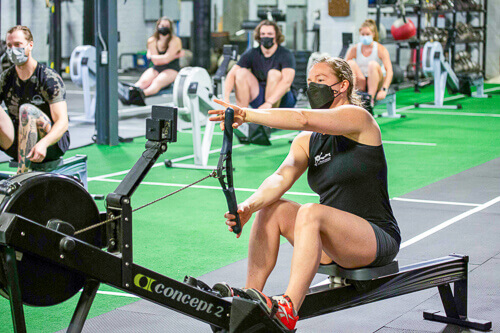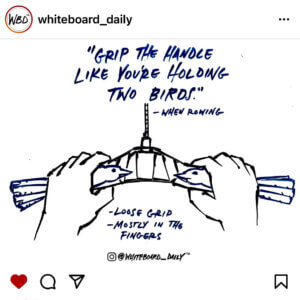Rowing Technique: The Best Rowing Machine Grip
Updated May 7, 2023
Not to get all “handsy” or anything, but let’s take a second to talk about something you might not have thought of: Your rowing machine grip.
Hand position in rowing. It’s more important than you think and if you’re not doing it correctly it could be causing you issues.
Why? Because the hands are one of the three main points of connection between your body and the machine (as well as the seat and the foot stretchers).
COACHES! Pay attention here, you’re going to want to know these answers for when your students ask!
5 Keys for the Best Hand Position in Rowing
Your rowing machine handle grip has everything to do with things that happen up the chain.
Like how well you engage your lats on the drive, whether you keep your shoulders down and even whether you have enough room to fully bring your knees up as you move into the catch position.
We asked UCanRow2 / Concept2 Master Instructor Cassi Niemann for her top tips to help you hold the handle correctly. Read on!
FIRST and foremost: You’re looking for a shoulder-width grip. For most people, that means the pinkies are at the edge of the handle. Not falling off, but right at the end.
This allows for a smooth retraction of the elbows through to the finish (Mmmm that sweet, smooth force curve.). It also helps you keep the shoulders down and engage your lats on the drive, which is important for getting power out of your stroke. And finally, it creates space between your arms that you might need to bring your knees up into the catch.
SECOND: This one is debated all the time but as a starting point and unless there’s good reason not to, we prefer to see the thumbs under the handle. Why? Because it allows for a more secure, loose rowing machine grip and better tracking of the arms into the finish.
[Want 5 free workouts to help you practice your rowing technique and explore how the rowing machine can help you boost your fitness? Download your free workout set here! ]
THIRD: Keep a loose grip to prevent those downstream issues. Too much tension in the hands can lead to too much tension in the forearms and elbows, and all of that can wreak havoc.
Remember that rowing is a repetitive motion. So if you’re gripping too tightly stroke after stroke it won’t be long before some real problems materialize.
Not only is the “death grip” a risk for injury, but it can also break the chain of power production from the TRUE center of power on the rowing stroke, your legs and hips.
Karl Eagleman of Whiteboard Daily (@whiteboard_daily on Instagram – give him a follow!) did a SPECTACULAR representation of what we’re talking about here.
We often use the external cue, “imagine that you’re holding two birds” when gripping the handle. Keep them from flying away but don’t choke them.
A good internal cue here is: Hook your hands on the handle.
FOURTH: We periodically see people thinking they’ll get a great bicep pump from turning their palms up in an underhand rowing machine grip. That supinated grip isn’t the most efficient or effective choice, however.
If building your biceps is your goal, you’ll get it done way better and faster if you put the rowing machine handle down and pick up a pair of dumbbells instead.
Instead, pronate your grip and hold the rowing machine handle with your palms facing down. This will help you recruit the larger muscles in your back and transfer that force into the machine.
Remember, more muscle recruitment = more meters!
FIFTH: If you row on a Concept2 machine or another with an ergonomic, angled handle, point those ends down!
The 10-degree bend in the handle lets you row with a natural arm and hand position. More comfortable and easier than the older straight wooden handle. (Psst… you can upgrade!).
So check your grip and make the changes! You may find it was all you needed to create a smoother, more comfortable stroke.
While We’re At It: Should You Wear Gloves When You Row?
This is another hot topic among indoor rowers. Should you wear gloves when you row? If given a choice we generally recommend that people row without gloves. That way you can focus on keeping that loose grip we mentioned above as well as a more direct connection with the handle.
Most people wear gloves to prevent blisters, especially on long workouts. But blisters are part of the game and a badge of honor in rowing (. Ultimately they turn to callouses and poof! Problem solved.
That being said, this one is NOT a hill we’re willing to die on. If rowing with gloves is important to you and helps you stay consistent on the machine, then row on, friend!
There you have it! Everything you wanted to know for the best rowing machine grip. Questions? Ask in the comments!
Recommended next steps:
Get 5 free workouts to help you practice your technique and explore how the rowing machine can help you boost your fitness: Grab our free workout set here!
Row-along workouts and workout series to help you get fitter faster at the BEST price: UCanRow2 on Demand


For what it’s worth, I’m a big fan of gloves (I hope it’s okay if I mention The Crew Stop here – they make terrific gloves for rowing).
I sweat profusely when I work out, and slippery palms and fingers resulted in me having to use the “death grip” to hold the handle, which too often resulted in tendinitis in my wrists and forearms. Wearing gloves from the aforementioned The Crew Stop, with their silicon grippers on the palms and fingers, solved that problem for me.
Great post! On the topic of gloves, I believe there is a time and place for them. Those times can be early in the season when your hands are still soft, at a rowing camp where you’re rowing double or triple sessions, if you have skin that doesn’t “callus” well, or if you have particularly sweaty hands and want to avoid over-gripping the handle. Full disclosure…I sell rowing gloves but I also use them when I scull and on the erg (I’m in the sweaty hands camp). My gloves are designed by rowers, for rowers. You can check them out at ScullingGear.com. Check out the video from the manufacturer on the product page to hear his view on how often and when you should use the gloves. (spoiler alert…NOT everyday!)
A rowing ergometer handle is a human/machine interface. At any such interface the machine should adapt to the natural movement of the user, not the user to the machine, as is the case with the single-piece, rigid stock handle. The standard advice to grip the handle lightly with an open finger curl is just the consensus strategy to deal with the non-compliant handle. This is called ‘good technique’ but it just an attempt to overcome the design defect of the C2 handle. Search the C2 Forum archives. Many, many users suffer from chronic wrist and elbow pain. In a recent forum thread five of the posters admitted to this, two of whom required corrective surgery. The stock C2 handle is a bio-mechanical abomination. It should have been relegated to the dust bin years ago.